Affiliate disclosure: This post may contain affiliate links. Please see our Privacy Policy.
You don’t often think of grandma’s flower garden as a good place to harvest your lunch, but there are a surprising number of tasty edibles growing in most perennial flower beds.
Beyond edible flowers, many (but not all) of these plants also have edible leaves, stems, and tubers too. Once you learn that common many common garden flowers are edible, you’ll never look at those formal flower plantings the same way.
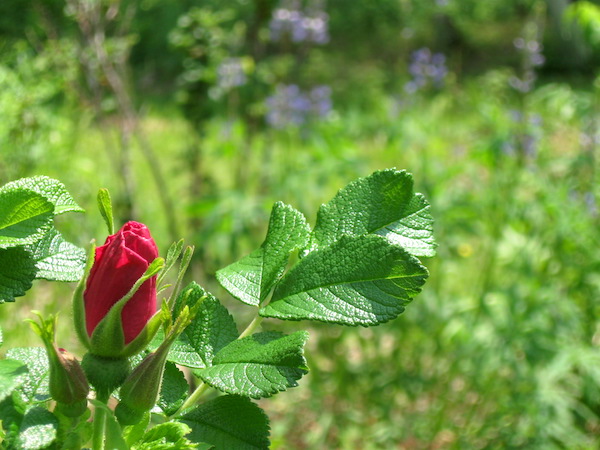
Table of Contents
- List of Edible Flowers
- Angelica
- Anise Hyssop
- Bachelor’s Buttons
- Bee Balm
- Begonia
- Borage
- Black Locust
- Calendula
- Carnations
- Chamomile
- Chickory
- Chives (and Other Alliums)
- Chrysanthemum
- Clover
- Daisy (Bellis perennis)
- Dame’s Rocket (Hesperis matronalis)
- Dandelions (Taraxacum officinale)
- Daylilies
- Elderflower
- Fireweed
- Forsythia (Forsythia sp.)
- Fruit Blossoms (Apple, Cherry, Strawberry, etc)
- Hibiscus
- Hollyhock
- Honeysuckle
- Hostas
- Lavender
- Lilac
- Linden
- Marshmallow
- Meadowsweet
- Milkweed
- Nasturtium
- Peonies
- Phlox (Phlox paniculata)
- Roses
- Scented Geraniums
- Sunflowers
- Tulips
- Violets
- Toxic Flowers
A few years ago a friend of mine asked me to write an excerpt for her book, Gardening Like a Ninja: A Guide to Sneaking Delicious Edibles into Your Landscape. My first thought was, why on earth would you have to sneak anything in? There are plenty of edible landscape plants in just about any yard, provided you know where to look.
The trick is, I didn’t always know where to look. Years ago, when we first moved to our homestead, our plan was to establish as many perennial edibles as possible. Our first step in establishing an edible landscape was to take stock of our foundation.
Taking a look at the plantings that already exist on your property, we learned that many of them were, in fact, tasty edibles, they’re just not the same ones you’d find in the grocery store. Hostas and peonies, for example, are both considered delicacies in Japan. I’d already read about those years ago, but I knew there must be more tasty edibles lurking in our yard already.
Quickly researching other established plants on our land led me to find tasty uses for catmint, roses, crabapples, black locust blossoms, daylilies, hibiscus, sumac, impatiens, linden trees, violets, lilacs, and tulips. Many of these plants were grown for their showy blooms, but those also happen to be edible flowers.
Beyond their edible flowers, many of them also have edible shoots, leaves, and tubers too. That means these simple flower garden plants not only offer tasty edible blossoms to top salads and flavor drinks, but they may also provide more substantial nutrition too.
Knowing our land was also the first step in taking ownership of what was ours. Somehow, knowing every bush and tree in the yard by name helped us find a connection to our plants and the world around us that I can’t imagine we’d have achieved otherwise. Strange as it may seem, walking into the yard and picking fresh violets and other edible flowers for a dinner salad with guests not only impressed my company but also helped make my house feel a lot more like a home.
Knowing that plants in your existing perennial beds are edible is also handy in other ways, especially if you’re a parent.
When I was a small child, I ate a significant portion of one of our hedge bushes, and my mom was quite concerned. She always thought that bush smelled funny, and must be toxic. After I’d eaten it, she searched high and low to identify it to make sure I’d be ok, only to find out that the strange hedge was actually a rosemary bush in bloom…
List of Edible Flowers
If you’re just looking for a quick list, here’s a quick list of edible flowers below. If you’re looking for some tasty recipes for using each flower, or wondering how they taste, read on my friends.
- Angelica
- Anise Hyssop
- Bachelors Buttons
- Bee Balm
- Begonia
- Borage
- Black Locust
- Calendula
- Carnations
- Chamomile
- Chickory
- Chives (and other alliums)
- Chrysanthemum
- Clover
- Daisy
- Dame’s Rocket
- Dandelions
- Daylilies
- Elderflower
- Fireweed
- Forsythia
- Fruit Blossoms (Apple, pear, plum, citrus, etc)
- Hibiscus
- Hollyhock
- Honeysuckle
- Hostas
- Lavender
- Lilac
- Linden
- Marshmallow
- Meadowsweet
- Milkweed
- Nasturtium
- Peonies
- Phlox
- Rose
- Scented Geraniums
- Sunflowers
- Tulips
- Violets
Angelica
An old school flower garden favorite, Angelica has been grown and eaten since the middle ages. The beautiful flowers are themselves edible, and you can eat them right out in the garden.
How does angelica taste? Floral, with hints of anise and carrot, along with a bit of mild bitterness.
The flower stalks are often candied, and it was a popular confection in the dark ages in Europe. According to Hank Shaw at Honest Food, here’s how to make candied angelica:
“First, you need to know what candied angelica is. It is a very old form of candy. Flavor and structure comes from the herb stems, sweetness from cane sugar. The stems are blanched, then soaked in heavy syrup, boiled in that syrup, soaked again — several times — until they turn translucent. You then dry the stems a bit and roll them in caster sugar.”
Angelica is also a medicinal flower, and it was revered as the “herb of angels” historically. According to WebMD, Angelica is used to treat heartburn, flatulence, loss of appetite, bed wetting, arthritis, stroke, dementia, circulation problems, anxiety, fever, and insomnia.
Quite the list! They also note that it was used historically to “bring the menses,” so don’t eat it if you’re pregnant.
We don’t grow angelica in the garden, but I found a wild patch next to our favorite summertime swimming hole last year. This summer, I’m excited about harvesting some of our own and trying out these angelica recipes:
- Angelica Creme Fraiche (Angelica Cultured in Goats Milk) ~ Forager Chef
- Angelica Seed Pound Cake ~ Forager Chef
- Rhubarb Compote with Angelica & Dried Cherries ~ Forager Chef
- Rhubarb and Angelica Jam ~ Saveur
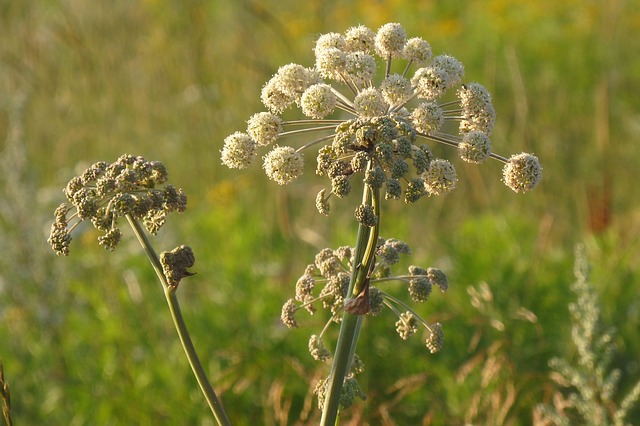
Anise Hyssop
A favorite of the bees, Anise Hyssop has a wonderful scent that fills the garden in midsummer. The flowers and leaves have a delicate black licorice flavor that’s pleasant but not overwhelming. They’re tasty fresh, or you can add anise hyssop blossoms to baked goods as well. Try any of these anise hyssop recipes:
- Anise Hyssop Woopie Pies ~ Homespun Seasonal Living
- Anise Hyssop Gumdrops ~ Homespun Seasonal Living
- Anise Hyssop Ice Tea ~ Taste Cooking
Still looking for more ideas? Here’s a list of things to do with Anise Hyssop. My favorite use? Just leaving it be and watching the bumble bees work the beautiful fragrant flowers in the summertime…
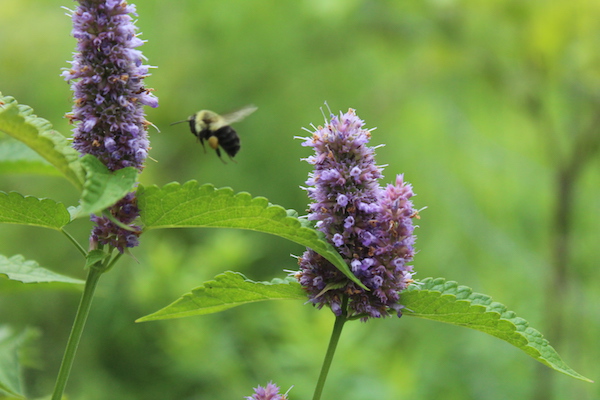
Bachelor’s Buttons
Also known as cornflower, bachelors buttons are bright blue edible flowers with a mild grassy flavor.
While the flower petals are a tasty edible, the green parts are much less pleasant. Carefully remove the green sepals around the flower to avoid their bitter taste.
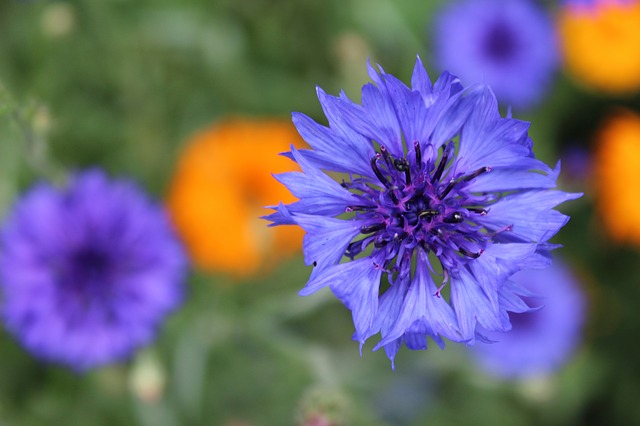
Bee Balm
One of the most carefree flowers we grow, bee balm grows like a weed in our soils. The bright red blooms attract hummingbirds in the summer, and I’ve actually seen groups of them fight over the sweet nectar. If you’ve never seen hummingbirds battle, it’s quite a sight, and those tiny delicate birds can really dish it out when competing for bee balm.
Bee balm flowers are also medicinal, with antimicrobial and antispasmodic properties. They’re commonly used to treat colds, flu, coughs, digestive upset, bloating, nausea and menstrual cramps. Typically, they’re used in salves to treat stings, scrapes and rashes.
Beyond that, bee balm blossoms are also a nervine that calms the whole nervous system during periods of stress and anxiety. That makes them the perfect summertime addition to cool drinks when you have way too much on your busy summer schedule.
There are dozens of ways to use bee balm, from teas to salves and herbal steams, but they’re also wonderful eaten simply as salad toppers or in a simple floral jelly.
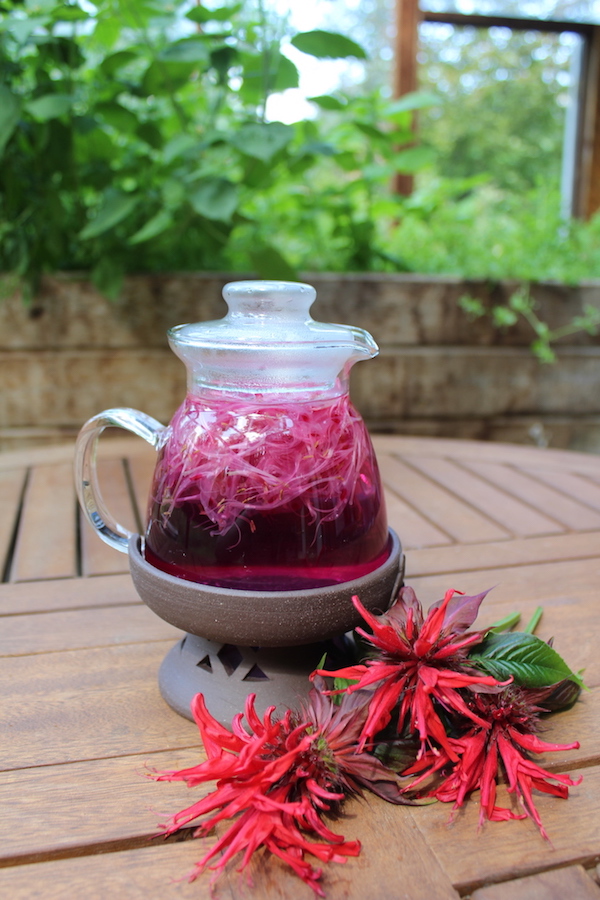
Begonia
With a bright citrus taste and a hint of sour, begonias are a flavorful edible flower that’s quite versatile. They can be eaten alongside savory or sweet dishes equally well. Eat the weeds notes that begonia blossoms and leaves are tasty raw, and that the stalks can be cooked like rhubarb.
Try any of these begonia recipes:
- Strawberry Begonia Salad ~ Sunset Magazine
- Begonia Flower Vinegar ~ PBS
- Begonia Fritters ~ Funny How Flowers Do That
- Begonia Cocktails ~Funny How Flowers Do That
- Vietnamese Summer Rolls with Begonias ~ Funny How Flowers Do That
- Grilled Sea Bass with Citrus Begonia Dressing ~ Funny How Flowers Do That
- Pistachio and Lemon Cream Tart with Sugared Begonias ~ Funny How Flowers Do That
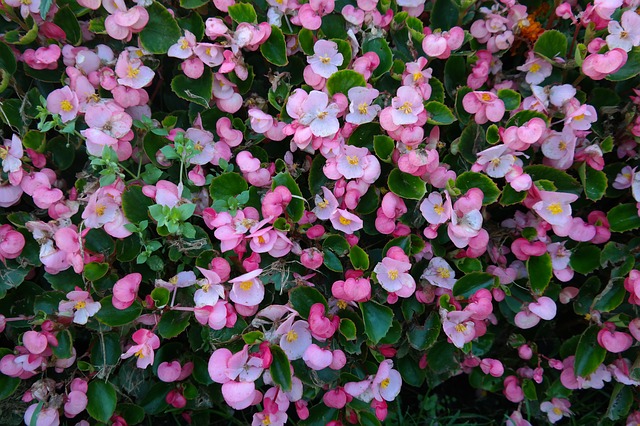
Borage
With a flavor reminiscent of fresh cucumbers, borage flowers are often added to cool summertime drinks. While the edible flowers tend to get all the attention, borage leaves are also edible and make a lovely green salad. The greens can also be served cooked, and added to anything in place of spinach.
Hank Shaw has a pretty thorough guide to cooking borage. Here are a few more borage recipes to keep you cooking:
- Borage Ravioli ~ Saveur
- Blackberry Borage Fool ~ Epicurious
- Borage Party Spread Appetizers ~ Taste of Home
- Borage Soup ~ The Seasonal Table
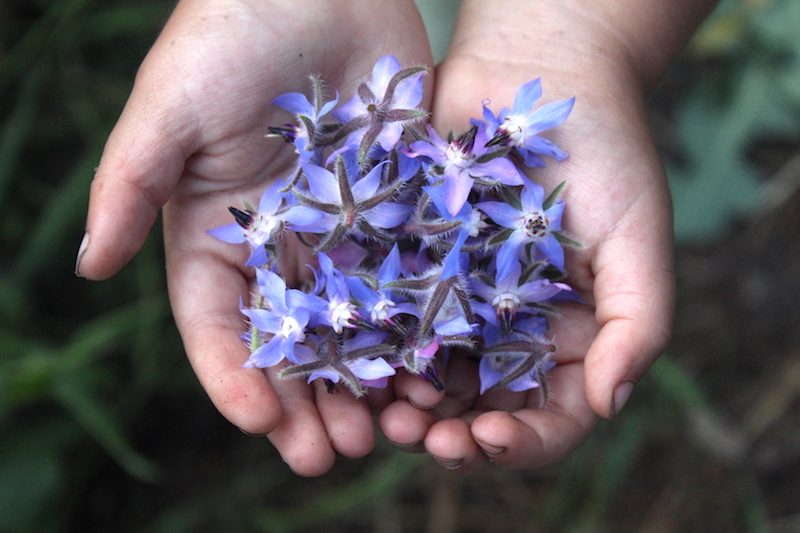
Black Locust
In the late spring and early summer, our black locust trees are covered with fragrant white blossoms. For about 2 to 3 weeks each year, you can smell them from many yards away. You can also “hear” them, as the trees attract so many bees that they seem to hum when in bloom.
The bees know where the good stuff is, and if you can manage it, pick a few of the edible blossoms to make black locust fritters! While that’s the most popular way to enjoy these fragrant edible flowers, there are also a few more black locust recipes you should try:
- Black Locust Flower Syrup ~ Nature on the Shelf
- Black Locust and Ricotta Crostini with Wild Mint ~ Foraged Foodie
- Black Locust Flower Jelly ~ Three Foragers
- White Wine and Locust Flower Jelly ~ Indiana Public Media
- Baked Salmon in Locust Blossom Cream Sauce ~ Northern Woodlands
- Locust Flower Sorbet ~ Backyard Forager
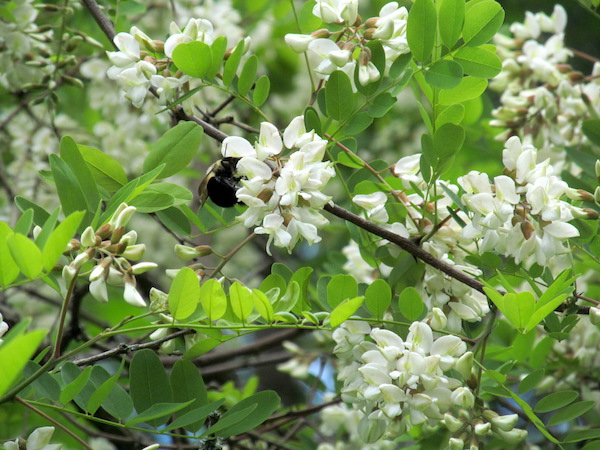
Calendula
The beautiful orange/yellow flowers of calendula make a beautiful annual in the flower garden, and their bright edible flower petals add color to all manner of dishes. For the most part, they add bright colors to recipes, but not a lot of flavor. They’re used to create these bright natural herbal cupcake sprinkles, and the petals are beautiful in these Calendula and thyme shortbread cookies.
A well-known herbal medicinal, calendula is often used topically to treat skin issues. We use a calendula infused oil on burns, but it’s also anti-inflammatory, antiviral, anti-fungal, anti-microbial, and astringent. This makes it the perfect choice for an all-purpose calendula salve.
Beyond its external uses, calendula is also used internally to treat muscle spasms, sore throat, menstrual cramps and stomach complaints (source).
Calendula flower is used to prevent muscle spasms, start menstrual periods, and reduce fever. It is also used for treating sore throat and mouth, menstrual cramps, cancer, and stomach and duodenal ulcers. Calendula has also been used for measles, smallpox, and jaundice.
Looking for more inspiration? Here are 10 things to make with calendula flowers.
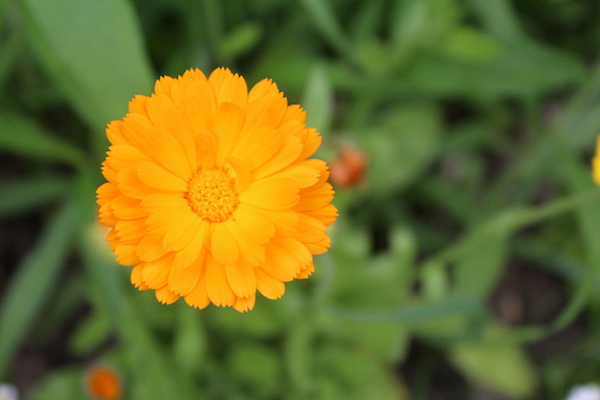
Carnations
As a kid, I remember my mother telling me that carnations were edible, but you couldn’t eat them because of all the pesticides/chemicals on them. Generally, in my neighborhood, if there were carnations they were in an expensive floral arrangement rather than your home garden.
While they are a high spray crop commonly used in floral arrangements, they can be grown without any chemicals in an organic manner…and that’s the best place to try eating them. Carnations can be used in many of the same ways as roses, and they impart a sweet/spicy flavor, along with their perfumed aroma. If you’re growing unsprayed carnations in your garden, try any of these carnation recipes:
- Flower Power Cake ~ Green Kitchen Stories
- Granola with Edible Flowers ~ 101 Cookbooks
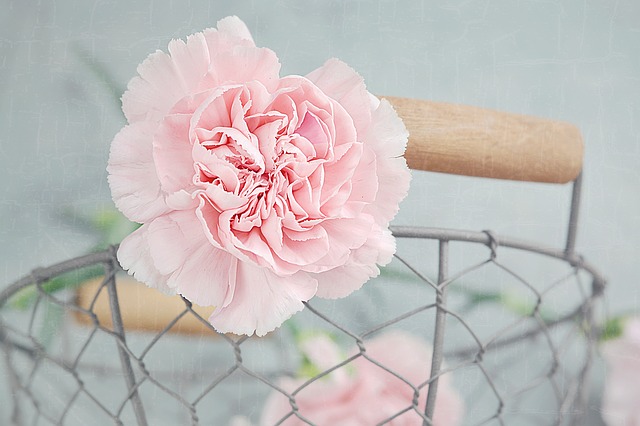
Chamomile
Best known as a simple relaxing herbal tea, chamomile can also be used to add a warm, sunny floral flavor to baked goods. Most people know how chamomile tea tastes and that same flavor infuses into cakes, jams scones, and buns. Try any of these delectable chamomile recipes:
- Honey Chamomile Tea Cake ~ Tikkido
- Chamomile Blueberry Scones ~ The Woodland Spoon
- Strawberry Chamomile Cake ~ Half Baked Harvest
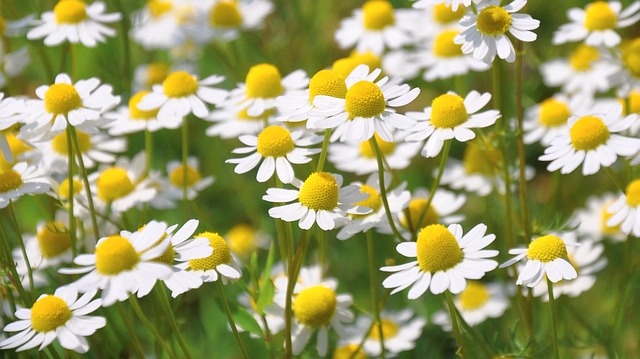
Chickory
Common Chickory (Cichorium intybus) is a perennial with beautiful blue flowers in mid-summer. It’s also a tasty edible root that’s actually cultivated for food in many parts of the world.
The greens are an edible raw or cooked, and the root is used for flavoring in many commercial coffee blends. Though the root is the best known edible part, the edible flowers make lovely additions to salads.
Try this recipe for sauteed chickory greens, and if you’re looking for more ideas, food and wine has a list of recipes for using chickory.
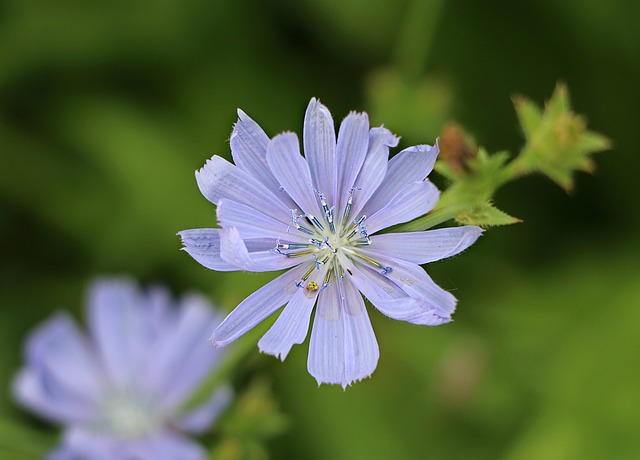
Chives (and Other Alliums)
Chive greens add an onion flavor, and they’re the perfect topping sprinkled on top of a baked potato. Chive blossoms are also edible, and while they taste similar, they do have a flavor all of their own. That same spicy allium flavor combines with subtle floral notes to create one of my favorite edible flowers.
I tend to eat them raw right out in the garden, which gives me a quick pick me up and gets me moving. They’re often added to salads, or preserved in chive blossom vinegar or chive blossom butter.
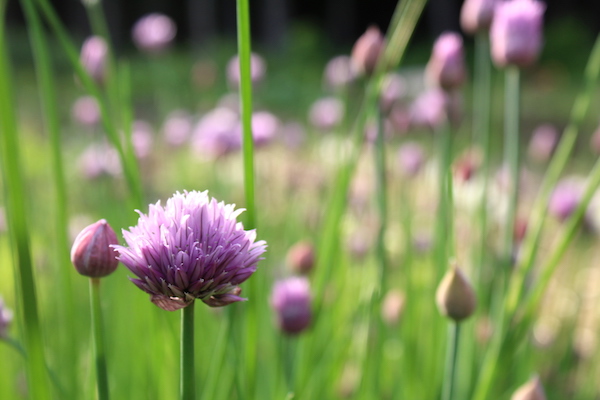
Chrysanthemum
When things turn cold during foliage season in Vermont, every grocery store, hardware store, nursery and tourist trap puts out the same chalkboard sign advertising “Hardy Mums!” I don’t know why, I know it’s juvenile, but it always makes me chuckle, bringing to mind some exceptionally robust and hardy grandmotherly figures.
Most people around these parts buy them in the fall and leave them in pots as decorations until early winter, and then compost them. A neighbor informed me that they’re actually perennials, and though he’s well over 80, he admitted to dumpster diving to rescue discarded mums.
But even more exciting…they’re edible flowers too!
Chrysanthemum greens are a cooked vegetable in Asian cuisine, and the edible flowers are commonly made into chrysanthemum tea. Here are a few recipes to try:
- Chrysanthemum Greens with Sesame Miso Dressing ~ Diversavore
- Herbal Chrysanthemum Tea ~ The Omnivores Cookbook
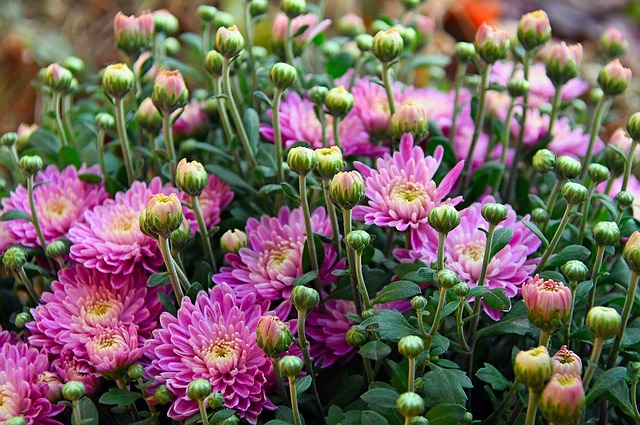
Clover
Red clover and white clover are both sweet edible flowers that can be harvested in huge quantities in the summer months. The flowers themselves can be dried and ground to make clover flour which adds nutrition and helps extend flour supplies during tough times.
The base of each clover flower produces a bit of sweet nectar, and many country kids know how to harvest clover flowers, peel back the leaves and get a drop of sweet honeydew from each flower. Personally, I just eat them whole in season for a sweet garden treat that tastes a bit like snap peas.
Beyond fresh clover flowers and ground clover flour, the blossoms can just be added to baked goods whole. Try any of these clover recipes:
- Red Clover Flour Muffins (Gluten-Free) ~ Clover Leaf Farm
- White Clover Flour Cookies ~ Southern Forager
- Clover Blossom Soda Bread ~ The Forages Feast
- Red Clover Biscuits ~ Edible Wild Food
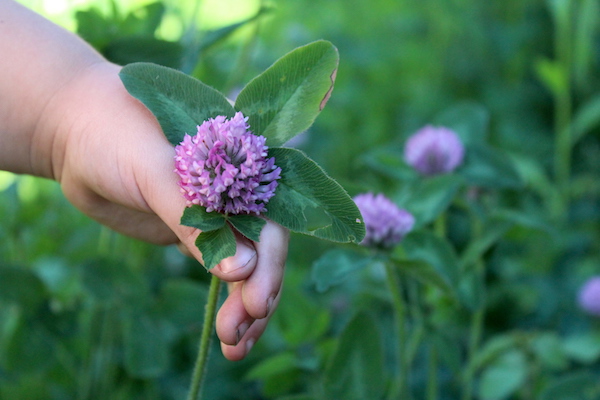
Daisy (Bellis perennis)
I’m always excited when I see daisy greens popping up in the early spring. They come out early, and though they’re a bit bitter, I’m happy to eat them as the snow is melting back in our northern climate. Later on in the year, daisies are bright sunny edible flowers that add more beauty than taste.
The flowers are slightly bitter, and I don’t find them particularly tasty. My young daughter, on the other hand, can’t get enough of them. Perhaps it’s a matter of taste buds, or maybe it’s just that she loves their beauty enough to forgive their flavor.
Generally, edible daisy flowers are used raw as a garnish.
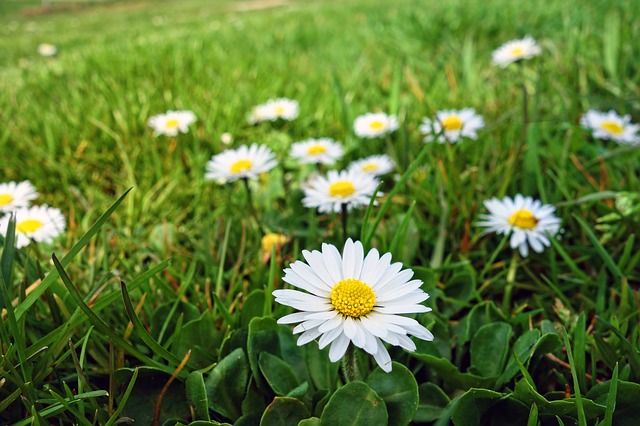
Dame’s Rocket (Hesperis matronalis)
A biennial plant in the broccoli family, Dame’s Rocket (Hesperis matronalis) is just as edible as any other garden brassica. It goes by many names, including dame’s rocket, damask-violet, dame’s-violet, dames-wort, dame’s gilliflower, night-scented gilliflower, queen’s gilliflower, rogue’s gilliflower, summer lilac, sweet rocket, mother-of-the-evening, and winter gilliflower.
Though it looks quite similar to tall perennial Phlox (Phlox paniculata), they’re not the same plant. Dame’s Rocket has 4 petals, while Phlox has 5. Incidentally, it’s phlox look-alike is also edible, so the distinction doesn’t really matter that much so far as edible flowers go.
Generally, the leaves are eaten before the plant flowers, and they’re added to salads. The flower buds are cooked and eaten like broccoli raab, and the edible flowers can be eaten raw or used as a garnish.
Forager Chef has a great article on foraging and cooking with Dame’s Rocket if you’re looking for specifics.
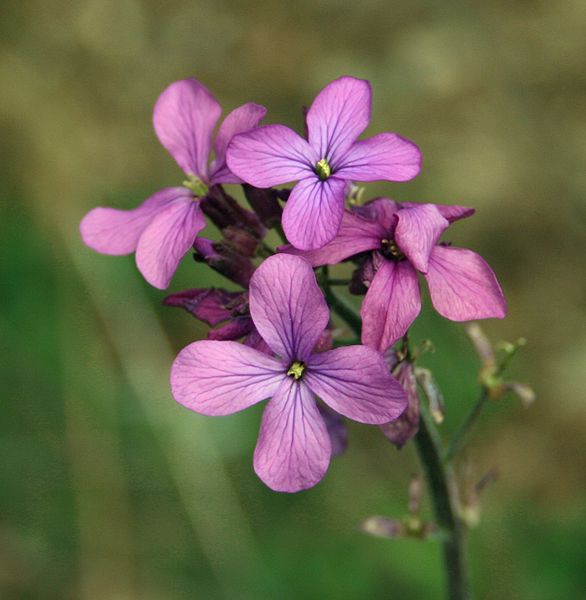
Dandelions (Taraxacum officinale)
Dandelion greens are one of the first spring greens, and they’re bitter right when your body needs a bit of a pick me up after a winter of heavy foods. They can be incorporated into dishes, like in this homemade dandelion pasta made with the greens right in the noodles. Dandelions are medicinal, used internally as a dandelion tincture for skin and urinary tract problems or externally in salves, massage oils and lotion bars for muscle aches.
Every part is edible. The greens are often cooked into savory dishes, or eaten raw to add a touch of bitter to salads. Dandelion roots are cooked like carrots, or dried, roasted and then ground into a dandelion coffee substitute. The flowers are often made into old fashioned dandelion wine, and my little ones love dandelion flower ice cream.
- Dandelion Petal and Lemon Cookies with Kale Drizzle ~ Veggie Desserts
- Dandelion and Honey Gummy Bears ~ Adamant Kitchen
- Dandelion Petal Bread ~ Homespun Seasonal Living
- Dandelion Shortbread Cookies ~ Adamant Kitchen
- Dandelion Donuts with Chocolate Frosting ~ Brooklyn Farm Girl
- Dandelion Root Muffins ~ Grow Forage Cook Ferment
- Fried Dandelion Blossoms ~ Simply Beyond Herbs
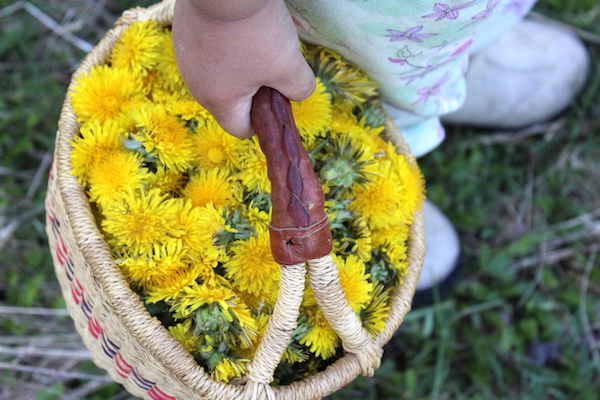
Daylilies
Most foragers know those wild daylilies are a special summertime treat, but that same treat that they hunt over hill and dale for in the countryside is likely growing in your suburban backyard. The unopened flower buds are commonly fried into daylily fritters or added to stir-fries.
Personally, I think the opened flowers taste the best and I love eating them whole. They have a honey-sweet crunch and a lovely floral taste.
Every part of a daylily is edible, including the roots and young shoots. Hunt Gather Cook has an excellent article on how to prepare each part.
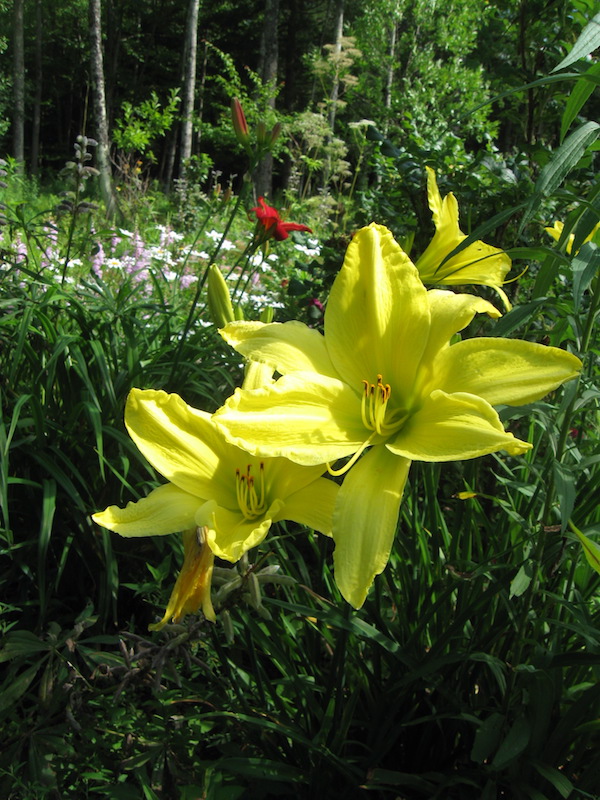
Elderflower
While elderflowers are delicious, and a truly one of a kind taste, more often than not I leave them on the plants because I want more elderberries. We make elderberry jam every year and it’s one of my favorites.
That said, elderflower wine is on my homebrewing bucket list, and this elderflower strawberry mead looks out of this world. Simple elderflower fritters are one of the most common ways to eat them outside of winemaking.
Though I’ve yet to try it, I’ve read that storing apples packed with elderflowers infuses flavor into the apples while they’re in a root cellar. At least according to the book Preserving Food without Canning or Freezing, the resulting apples taste like pineapple. That must have seemed pretty magical 200 years ago…
Here are a few more modern elderberry recipes to try:
- Lemon Elderflower Popsicles ~ Occasionally Eggs
- Lemon Elderflower Cake ~ Liv for Cake
- Elderflower Kombucha ~ Homestead Honey
- Elderflower Marshmallows ~ Nitty Gritty Life

Fireweed
I’m told that fireweed jelly is a huge hit in Alaska, where the blossoms are used to mark the progression of summer. They start blooming at the bottom and work their way up as the season progresses.
Generally, these flowers are wild foraged, which is no big deal since they often grow in huge patches (as soon as you find one, there’s more nearby). The trick is, they require a cool climate.
Beyond a jelly with the edible flowers, I’ve just read that the leaves of fireweed can be made into a tea substitute. According to Honest Food, “You make fireweed tea by stripping the leaves off the stalks, bruising them in some way, letting them oxidize and ferment, then drying and storing them. This is more or less the same way traditional tea is made.”
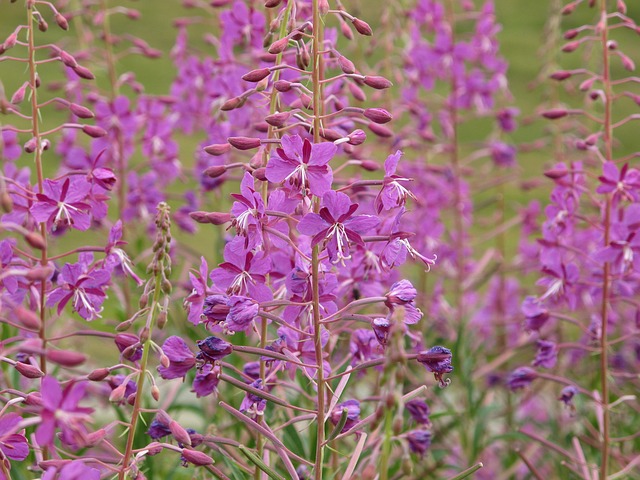
Forsythia (Forsythia sp.)
These bright yellow blossoms burst forth in firey bushes, well before the leaves emerge. I’ve always wanted one because they signal spring like nothing else here in the north country.
I recently got a chance to try the blossoms from a neighbor, and while they’re beautiful, I found them pretty tasteless. Maybe they were past their peak? Maybe it’s a variety thing.
I can’t say, but recipes using the edible flowers from forsythia are quite common and other’s seem to enjoy their flavor:
- Cherry Forsythia Scones ~ Healing Harvest Homestead
- Forsythia Jelly ~ The Free Range Life
- Forsythia Syrup ~ Grow Forage Cook Ferment
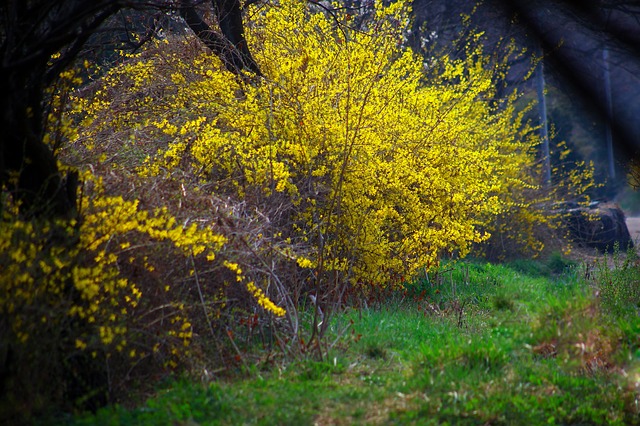
Fruit Blossoms (Apple, Cherry, Strawberry, etc)
The flowers of many fruiting trees and shrubs are edible long before they set fruit. The problem is if you eat the flowers they won’t turn into fruit.
This is a good way to thin a crop if your apple tree is over-producing. Thinning the blossoms ensures that the remaining fruit will be larger and helps prevent stress on the tree.
You can find edible flowers on apples, cherries, plums, citrus, and many other trees. Fruiting shrubs like strawberries, honeyberries, and blueberries are also edible. They’re not used all that often in recipes because most people prefer fruit to edible flowers, but here are a few ideas:
- Flourless Chocolate Torte with Plum Blossoms ~ Nitty Gritty Life
- Plum Blossom Coridal ~ Gather Victoria
- Cherry Blossom Cookies ~ Just One Cookbook
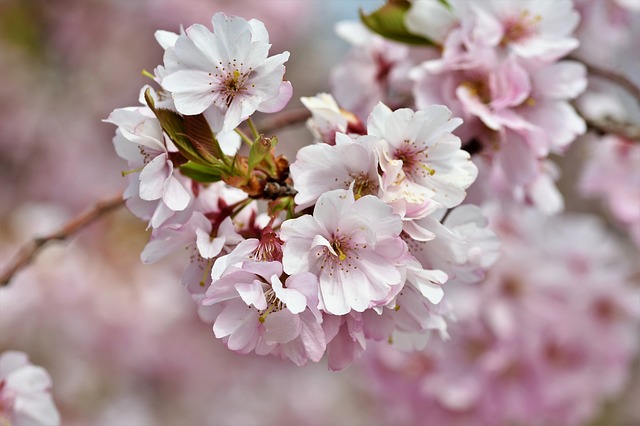
Hibiscus
If you’ve ever heard of hibiscus tea, maybe you never made the connection to that tropical flower in the garden. They’re one and the same, and that sweet/tart floral tea captures the very essence of hibiscus. The blossoms taste a bit like cranberry, and they often stain foods bright red during cooking.
Unlike many edible flower recipes that are best sweet, hibiscus is more versatile and you’ll find it in all manner of savory recipes too. They’re commonly eaten in Latin American countries, so many of the recipes have a Latin twist.
Here are a few to get you started:
- Hibiscus Flower Enchiladas ~ Love and Olive Oil
- Hibiscus Margaritas ~ Minimalist Baker
- Vegan Hibiscus Flower Tacos ~ All Recipes
- Hibiscus Loaf Cake ~ Serious Eats
- Hibiscus Flower Quesadillas ~ Feasting at Home
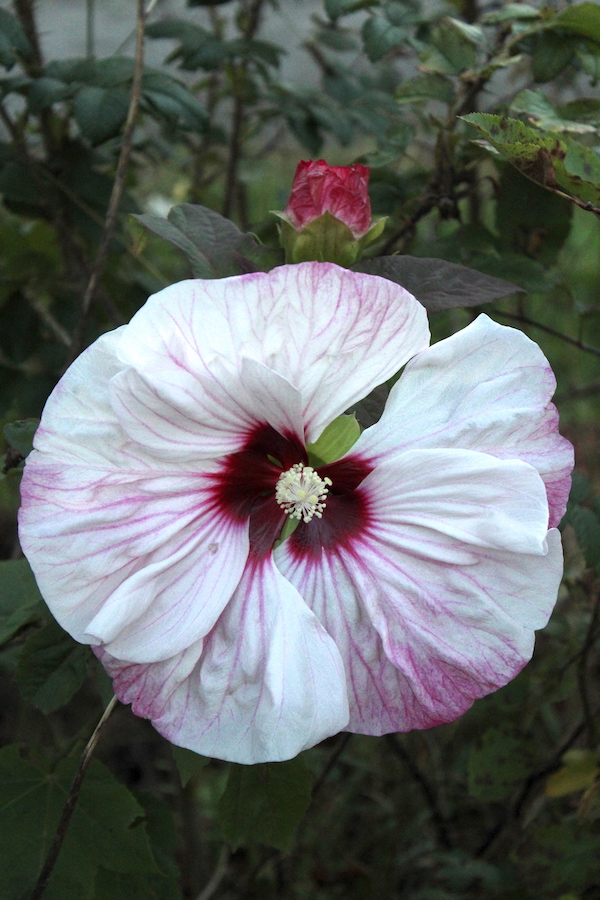
Hollyhock
Related to marshmallow flowers, hollyhocks are also edible flowers. They’re a bit bland, with a mild vegetable flavor, but they add a beautiful touch to fresh salads.
Just like marshmallow, every part of the plant is edible. The leaves make a good fresh salad green, and all parts of the hollyhock plant can be used as a medicinal tea for pain and inflammation.
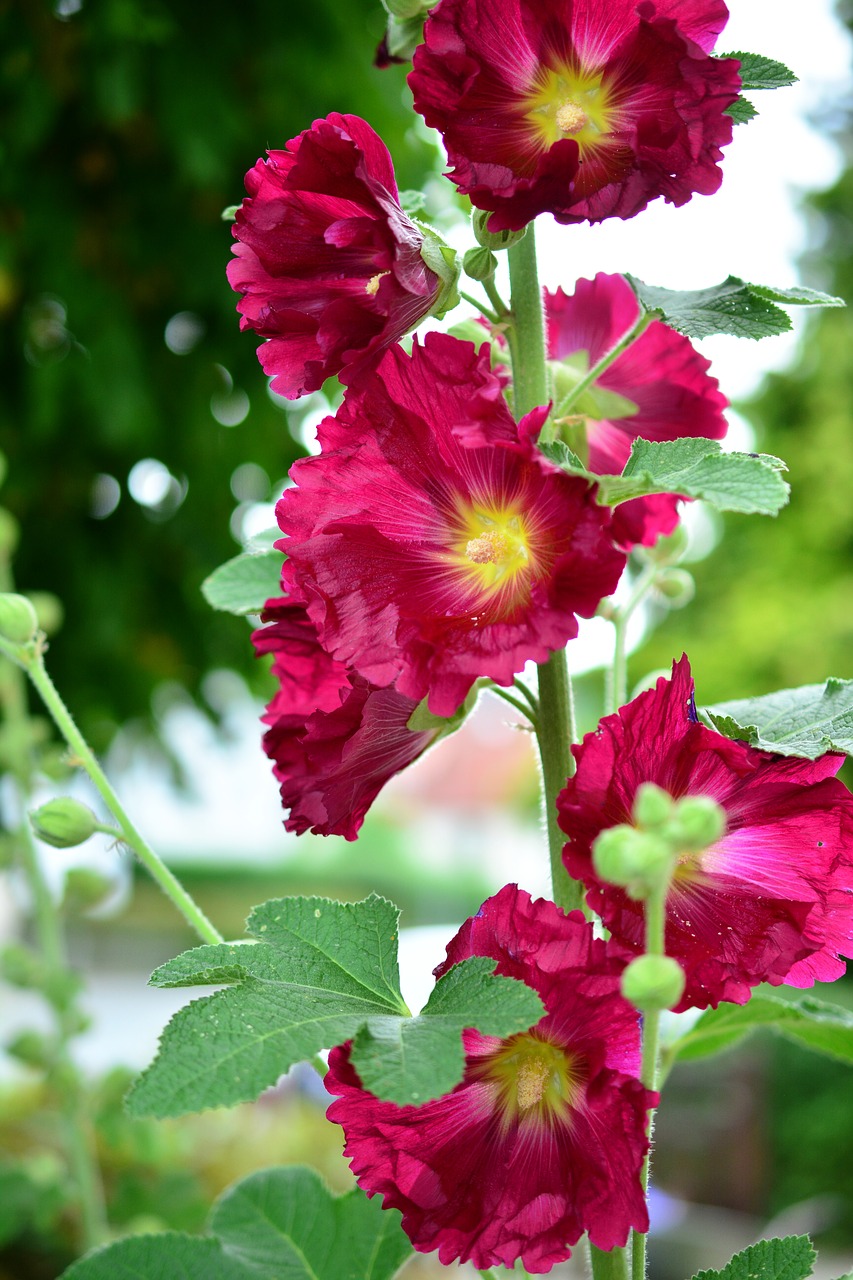
Honeysuckle
Ever walk by honeysuckle in the garden and think, “that smells good enough to eat!” You’re in luck, go right ahead! The same sugars that entice bees and hummingbirds are in the blossoms for us to eat as well, and that delightful scent comes through in the flavor of the flowers.
I love making honeysuckle syrup because it’s simple to make and versatile, but there’s plenty of ways to use honeysuckle:
Beyond just being edible, honeysuckle is also medicinal. A honeysuckle extract, like this homemade honeysuckle glycerite, can be used to treat sore throat, cool hot flashes and ease respiratory infections.
Keep in mind that unlike some of the other edible flowers on this list, where many parts of the plant are edible, other parts of honeysuckle are toxic. Do not eat honeysuckle berries later in the season, just stick to the fragrant early season edible flowers.
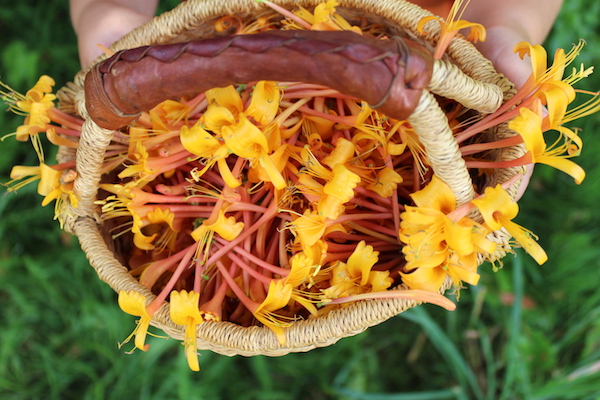
Hostas
Though we often think of garden hostas for their leaves, they also put out a profusion of blossoms mid-summer. The blossoms are edible and taste refreshing and mild. Beyond the edible flowers, the flower stalks, leaves, and young spring shoots are also edible.
Young hosta shoots taste similar to asparagus and can be cooked in the same manner, or eaten raw in salads. Harvesting sparingly won’t hurt the plant, and you’ll still have a lovely shade perennial later in the season. They’re actually a popular vegetable in Japan, and I bet they’d wonder why we’re not eating them.
Later in the season, their edible flowers taste sweet and floral. They can be added to salads, eaten out of hand, or fried up into tasty fritters.
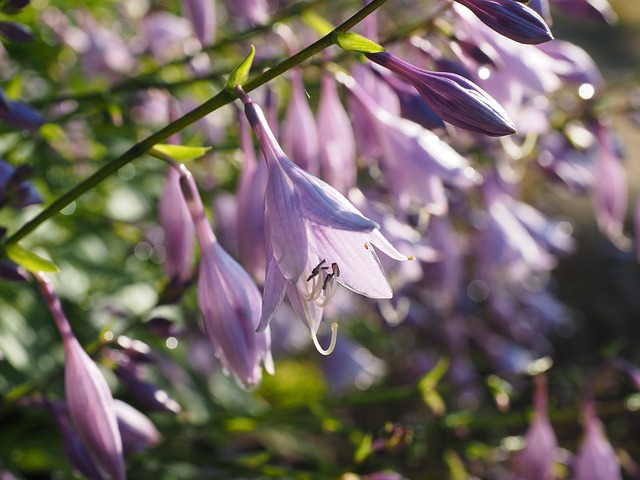
Lavender
I often think of lavender as just a scent for body products, like this homemade lavender soap, lavender salt soak, lavender oatmeal bath, and even a lavender face mask. Adding lavender to food works just as well, and can create a really unique taste.
Lavender goes particularly well with chocolate or honey in my opinion, but there’s plenty of ways to use it…
- Lavender Lemonade Prosecco Cocktail ~ Happiness is Homemade
- Lemon Lavender Madeleines ~ Chocolates and Chai
- Lavender Infused Gin ~ Sidewalk Shoes
- Lemon Lavender Bundt Cake ~ Recipes from a Pantry
- Almond Lavender Biscotti ~ Sidewalk Shoes
- Small Batch Blueberry Lavender Jam ~ Life Currents
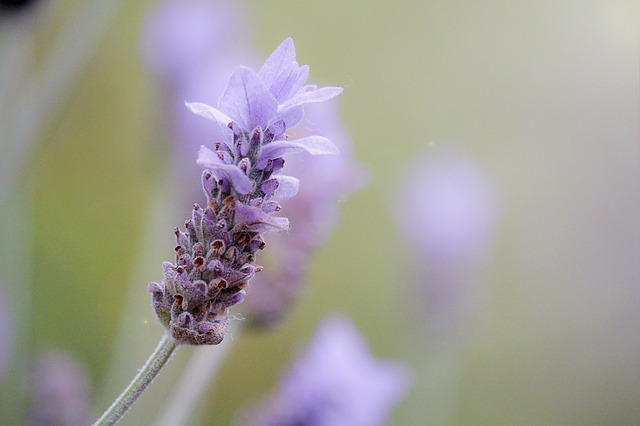
Lilac
A real treat for the nose and candy for the eyes, lilacs are also tasty to eat! Like many edible flowers, they taste an awful lot like they smell. One of the simplest ways to use them is making a simple lilac sugar.
There are a lot of creative ways to cook with lilacs, here are a few ideas to get you started:
- Lilac Lemon Grapefruit Sherbet ~ Will Frolic For Food
- Lilac Water ~ Feasting at Home
- Lilac Syrup ~ The Kitchen McCabe
- Lilac Wine ~ And Here We Are
- Lilac Honey Cake ~ Homespun Seasonal Living
- Lilac Cheesecake ~ Unconventional Baker
Seeking more? Here are 20+ Lilac Recipes for every meal, both savory & sweet.
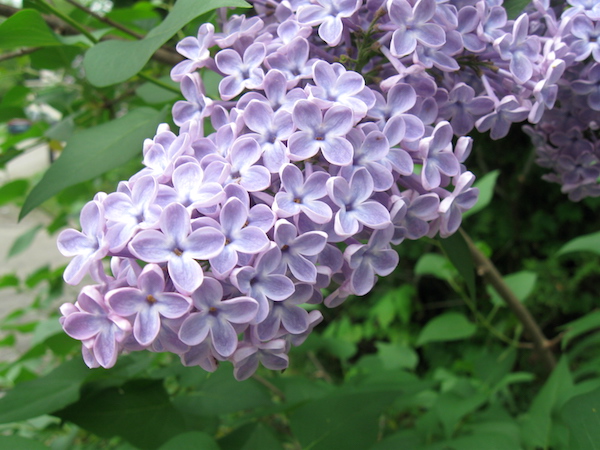
Linden
While most edible flowers are found in the perennial garden, a few are found on trees. Lindens trees grow all over our woods, and they’re a beautiful landscape tree that’s often found in suburban backyards. Linden flower tea is medicinal and is often used by herbalists for treating anxiety and hyperactivity (as well as ADHD in children).
I just found a recipe in The Turkish Cookbook for a natural wild yeast starter that uses linden flowers, and it’s used to leaven sweetbreads in the Middle East. I’m going to try it out as soon as the linden trees bloom in early summer here in Vermont.
There are also some historical records that indicate that linden seed pods and flowers were once blended and used as a chocolate substitute in Europe. I tried making linden chocolate from our American trees I wasn’t particularly successful.
My favorite use thus far? A simple linden flower mead (honey wine).
Beyond that, here are a few linden flower recipes to try:
- Linden Flower Syrup ~ Garden of Eating
- Blueberry Linden Flower Whiskey Smash ~ Moody Mixologist
- Linden Blossom Suncake ~ Gather Victoria
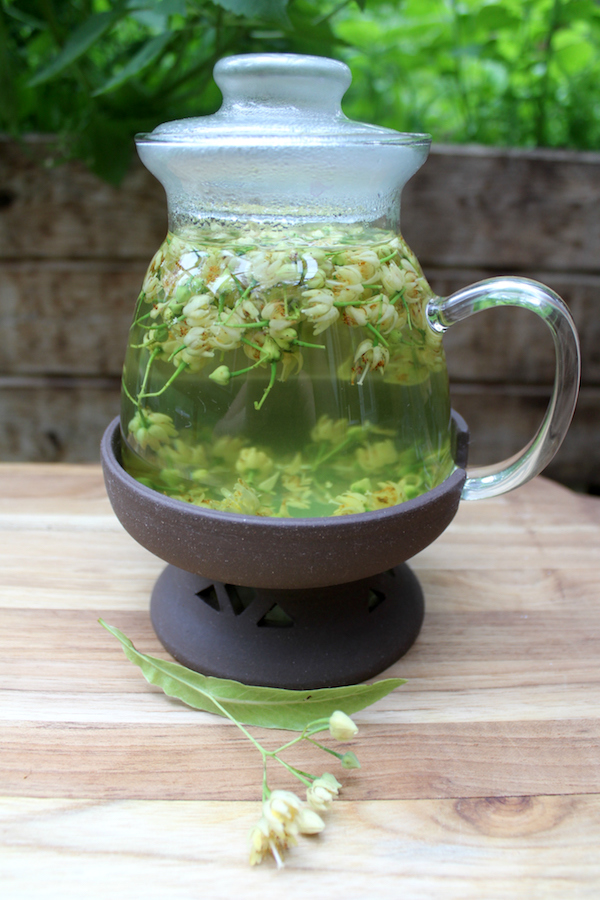
Marshmallow
Yes, marshmallows do grow right in the flower garden, or at least they used to. These days, commercial marshmallows are made from corn syrup and gelatin, but they used to be made from marshmallow and honey back in the middle ages. Every part of the marshmallow plant is edible, including the beautiful fragrant pink flowers.
The leaves are a tasty spring green, and the roots are commonly used in medicinal preparations to soothe mucous membranes. That same mucilage that’s used to treat a sore throat is also what helps herbal marshmallows gel. Marshmallows can also be made from the green seed pods after the edible flowers have been pollinated by local bees (and the bees really love these flowers).
If you want to try to make your own herbal marshmallows with just marshmallow plants and honey, there are detailed instructions in the book Edible Wild Plants: Wild Foods from Dirt to Plate. Marshmallow plants grow wild all over the world, so they’re actually foraged as well as grown right in the flower garden.
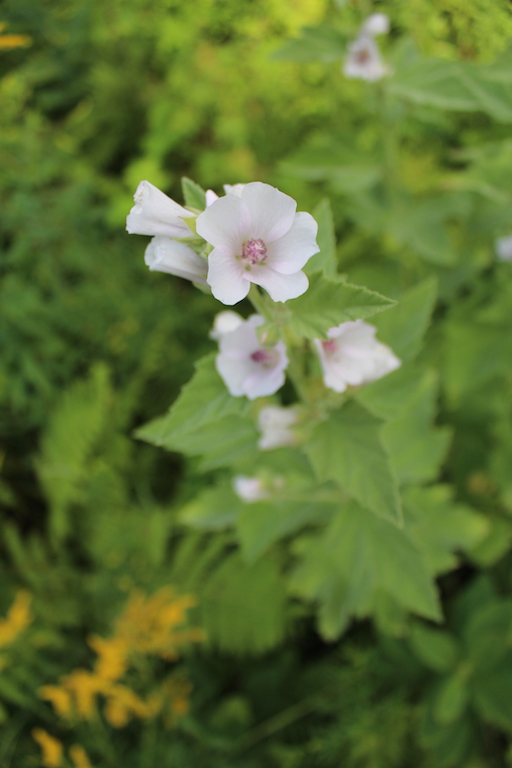
Meadowsweet
Meadowsweet is light and floral, and it’s often used in the same way as elderflowers. According to Learning Herbs, it’s also a home remedy for pain and fever.
- Meadowsweet Cordial ~ Craft Invaders
- Meadowsweet Sorbet ~ Eat the Weeds
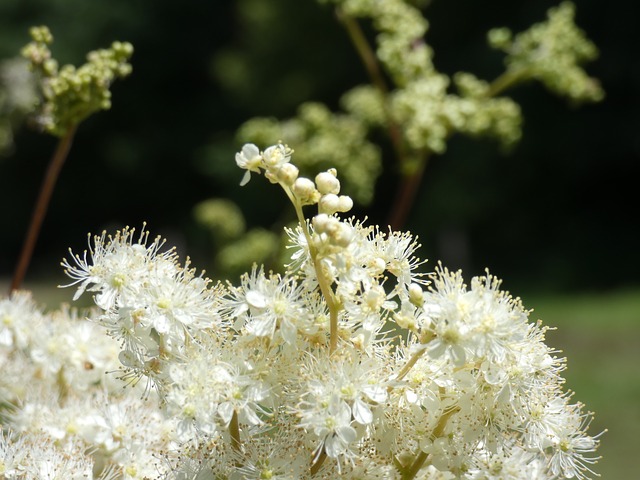
Milkweed
It’s becoming more common to plant milkweed in flower beds, as a nice gesture for the monarch butterflies, but also because they’re beautiful and smell wonderful. Knowing they’re edible flowers is just one more reason to plant them in your flower garden.
The edible species is common milkweed (Asclepias syriaca). There are some reports that common milkweed is toxic, and that goes back to a foraging book from the 1970s where an author actually misidentified a plant thinking it was milkweed (dogbane instead of milkweed). That species is toxic, and tastes horrible.
Since then, hundreds of resources have just copied that information without checking, each one says “it’s unpalatably bitter.” While dogbane is horribly bitter and toxic, common milkweed is not, that incorrect information has been perpetuated for decades.
As always, with any wild edible use your best judgment and consult plenty of sources before making a decision to eat it, don’t just take my word for it. In any case, there are toxic look-alikes for common milkweed, so be 100% sure on your identification too…
Beyond the edible flowers, there are a number of other edible parts on milkweed including the shoots, flower buds, leaves, seed pods, and immature seeds. All parts should be cooked before eating.
If you’re looking for other milkweed eating resources, here are a few:
- Cooking Milkweed Shoots from Forager Chef
- Milkweed: A Remarkable Wild Vegetable from Countryside Network
- Eating Common Milkweed from Eat the Weeds
- Eating Milkweed from The Maine Organic Farmer’s Association
I’ve tried cooking up the young shoots, the flower buds, the flowers, the seed pods and the young seeds themselves. All were wonderful, but each a completely different vegetable.
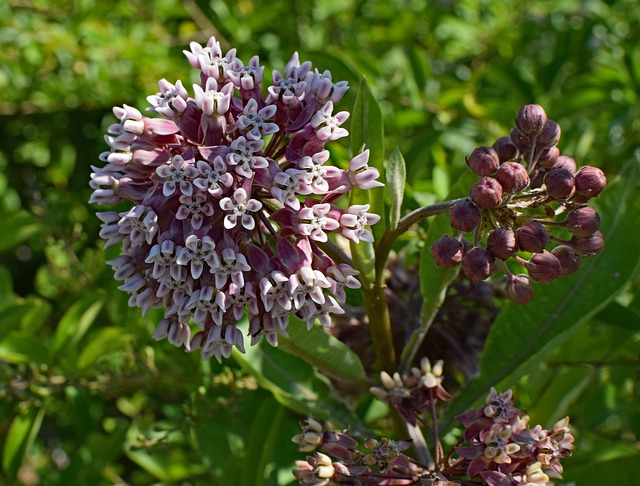
Nasturtium
One of the best known edible flowers, nasturtiums are annual flowers commonly grown for adding spice and color to salads. The buds of nasturtium flowers can be made into capers, and the flowers themselves are pretty versatile. Try these nasturtium recipes:
- Stuffed Nasturtium Leaves ~ Attainable Sustainable
- Nasturtium Pesto ~ You Grow Girl
- Nasturtium Salad with Dates and Pistachios ~ Simple Bites
- Goat Cheese Nasturtium Ice Cream ~ The Daily Meal
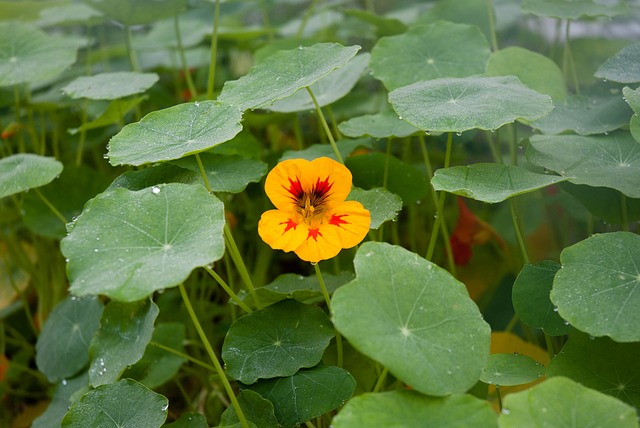
Peonies
Collecting peony petals as they fall, and not hurting your beautiful blooms, is a great way to get a second use out of a lovely midsummer flower. The petals can be lightly steamed and sweetened as they are in the east.
Peonies can also be made into peony water or added to cool summertime beverages. Some time ago I remember reading that this is how they were consumed in Europe in the middle ages, but alas I can no longer find the source.
Beyond their edible flowers, peonies are used medicinally in China, where dried peony root is sold as Bai Shao. According to WebMD, “Peony is used for gout, osteoarthritis, fever, respiratory tract illnesses, and cough. Women use peony for menstrual cramps, polycystic ovary syndrome, premenstrual syndrome (PMS), and for starting menstruation or causing an abortion. It is also used for viral hepatitis, liver cirrhosis, upset stomach, muscle cramps, “hardening of the arteries” (atherosclerosis), and to cause vomiting. Peony is also used for spasms, whooping cough (pertussis), epilepsy, nerve pain (neuralgia), migraine headache, and chronic fatigue syndrome (CFS).”
I make a tea from dried peony root to treat painful menstrual cramps, and it’s a medicine with a truly pleasant taste. You can also buy peony root glycerite for medicinal use.
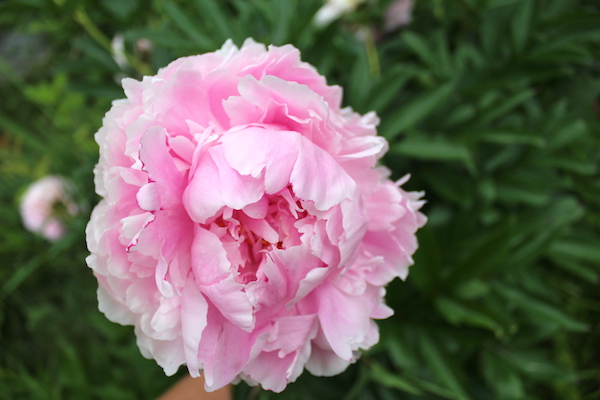
Phlox (Phlox paniculata)
While low growing creeping Phlox is toxic, the tall type of perennial phlox (Phlox paniculata) is edible and resembles Dame’s Rocket. The main difference is phlox has 5 petals, while dame’s rocket has 4.
The flowers are slightly spicy, and they’re often used in salads.
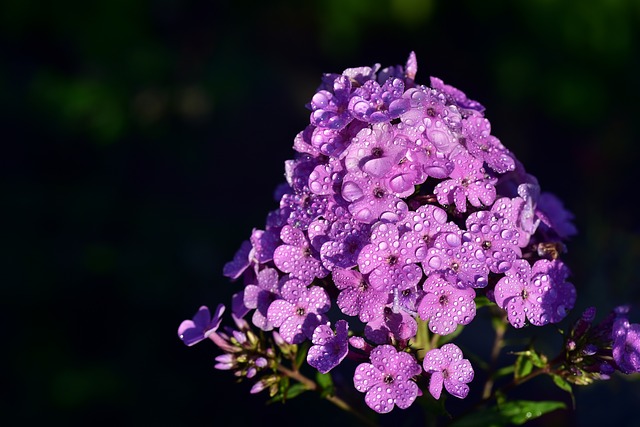
Roses
Not just edible, roses are delicious! How do they taste you ask? Well, about how they smell.
Rosewater is just a rose extract, and it’s been used to add wonderful flavor to dishes for millennia. It’s a traditional addition to baklava, to add lightness and intrigue to a dish that’s otherwise heavy with butter and honey.
Fresh rose petals taste wonderfully floral, and you can add them to salads or eat them out of hand. I find that adding a bit of sugar makes a truly divine treat. I make a simple rose cordial from rose blossoms, sugar and a bit of citric acid for tartness.
That simple rose cordial is great for flavoring all manner of things, and I use it to make rose soda for my daughter in the summer months. It can also add rose flavor to more grown-up drinks. They’re also wonderful in baked goods or drinks, like in any of these rose recipes:
- Rose Shortbread ~ What a Girl Eats
- Rose Cake with Fresh Rose Petals ~ Family Spice
- Vegan Almond Rose Chai Latte ~ Moon and Spoon and Yum
- Rose Pistachio Cookies ~ Recipes from a Pantry
- Rose Petal Infused Honey ~ Holistic Health Herbalist
Rose hips make a lovely jelly, and they’re full of vitamin C. We add them to herbal tea when we’re sick, along with echinacea and elderberry. You can also buy rose hip tincture for that same purpose.
If you’re excited about cooking with roses, check out this post on How to Eat a Rose for literally dozens of rose flavored treats.
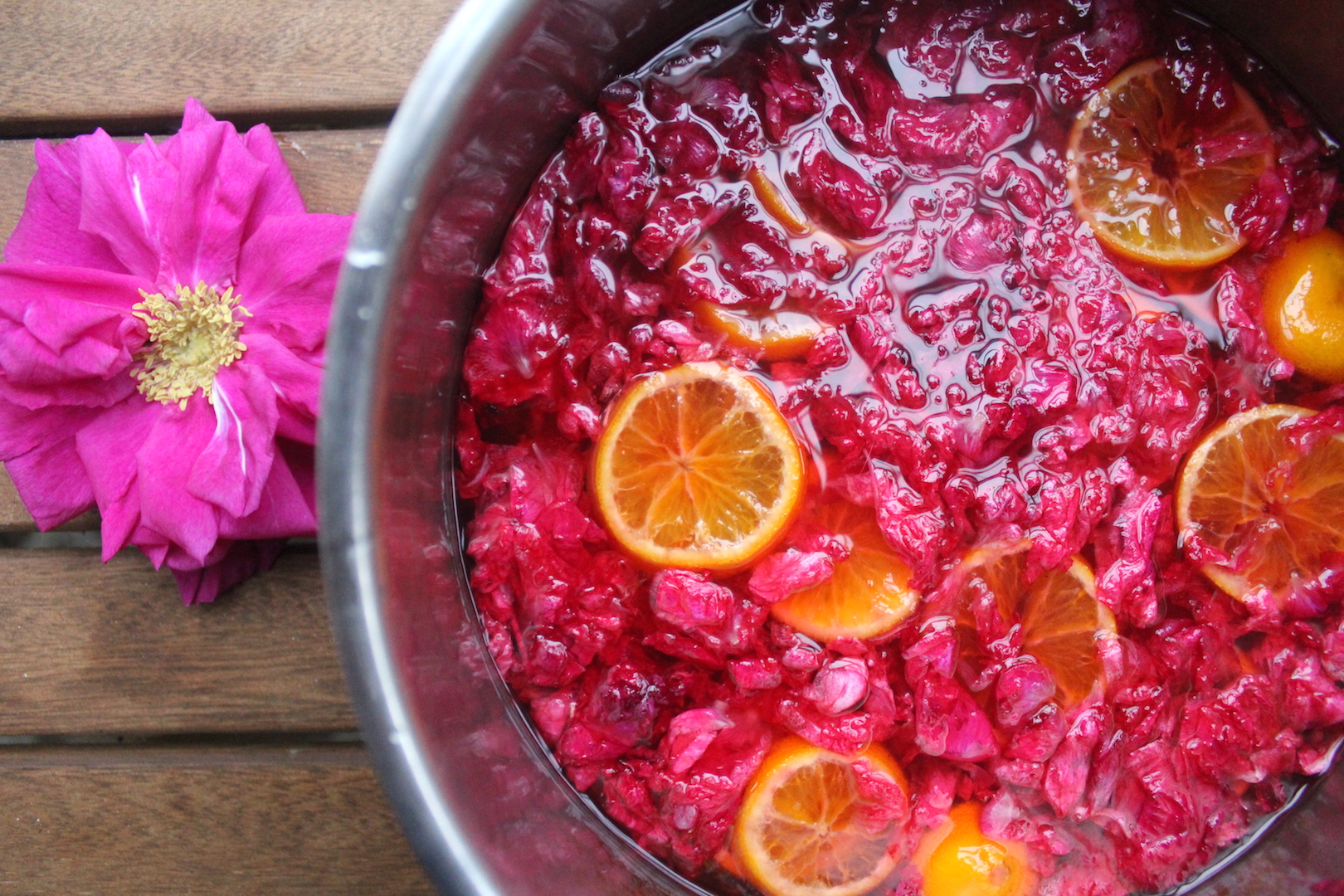
Scented Geraniums
Another edible flower that tastes just like they smell, scented geraniums add a delightfully floral flavor to dishes.
- Scented Geranium Cake ~ Hearth and Vine
- Scented Geranium Lemonade ~ Splendid Table
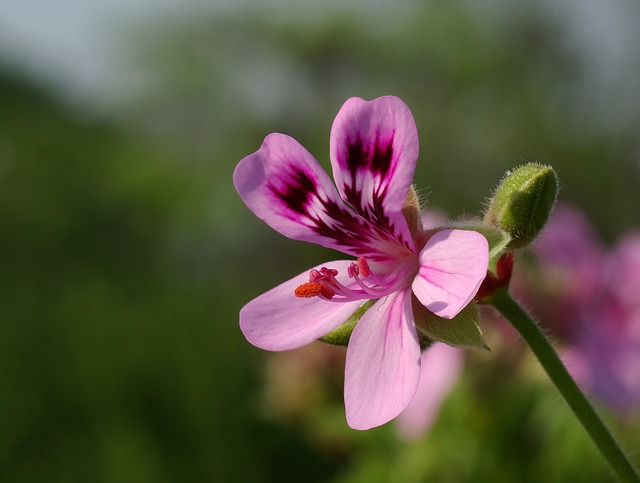
Sunflowers
Sunflowers are grown for their seeds as well as their beautiful flowers, but the flowers themselves are actually edible. Young sunflowers can be prepared and cooked like artichokes before they’re fully open. Forager Chef has a wonderful article on this, aptly titled “How to Cook Sunflower Buds Like an Artichoke.”
Once the flowers open fully, the flowers are still edible, they’re just trickier to use. Try using the petals to add color to recipes.
Like many edible flowers, the rest of the plant is also edible. Sunflower sprouts are some of my favorite micro greens, and mature sunflower leaves are technically edible as well.
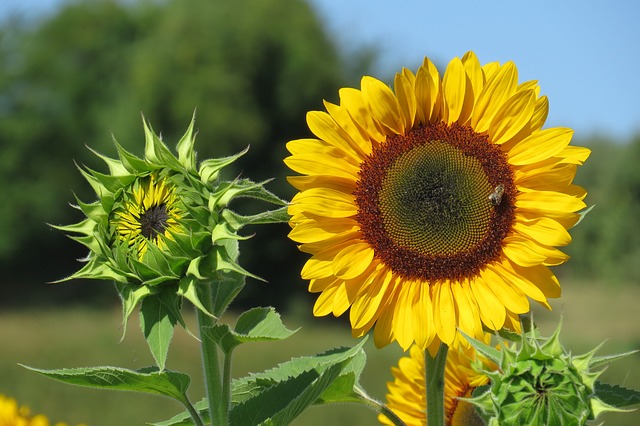
Tulips
Tulip flowers are edible, as are tulip bulbs. This came in handy during WWII when people in Holland were forced to cook their prized tulip bulbs like potatoes when food ran short.
This recipe for tulip bulb soup still survives, but by all accounts, tulip bulbs are not tasty. They’re more of survival food than anything else. The edible flowers, on the other hand, are a real treat.
Tulip petals vary quite a bit by variety, some sweet, others a tad spicy. According to Eat the Weeds, “They can have many flavors: Bland, beans, peas, and cucumbers. Pink, peach and white blossoms are the sweetest, red and yellow the most flavorful. While you can use them to garnish salads their more common use is to hold appetizers or dip. If you use the entire blossom cut off the pistil and stamens from the center of the blossom. The ends of the petals can also be bitter so cut them off as well when used individually.”
I also found a guide to the tastiest tulip varieties, most of which are red & white striped.
A word of caution, tulips can cause contact dermatitis in some people, so be careful. I’ve never had an issue with them, and my little ones love the bright petals.
This year I made chocolate mousse filled tulip cups as a spring treat (happy mother’s day to me!), but I’ve also found a few other tulip recipes to share. Unfortunately, it’s quite popular to cut a cherry tomato in a decorative way to make it look like a tulip, and when you search edible tulip recipes, these mock tulips are pretty much all you’ll find. Still, I dug deep and found a few lovely ideas for you:
- Stuffed Tulip Cheese Balls ~ Gather Victoria
- Primavera Tulips stuffed with Mushrooms & Parmesan ~ Great British Chefs
- Cheesecake Stuffed Tulips ~ Twigg Studios
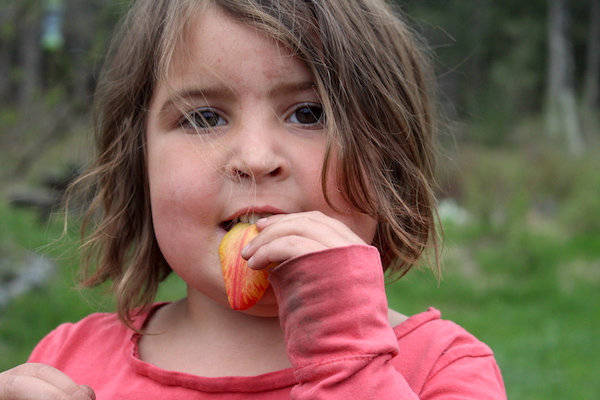
Violets
With a sweet floral taste, violets are a lovely edible flower for topping salads. They bloom in the spring when linden trees are just starting to grow in their giant tasty leaves.
I love making a wild foraged salad with linden leaves as the green, topped with fresh violets. It’s simple and wonderfully refreshing just as temperatures are starting to warm up.
Violets also make stunning candied flowers, and they’re commonly used to decorate cakes and cookies. The greens are also edible, and here’s a good guide to foraging and using wild violets including both the edible flowers and fresh violet greens.
Beyond that, here are a few more violet recipes:
- Violet Simple Syrup ~ Feasting at Home
- Wild Violet Muffins ~ Farm Fresh Eats
- Violet Tapioca Balls ~ The Wondersmith
- Wild Violet Sugar Valentines ~ Gather Victoria
- Violet and Dandelion Pink Lemonade ~ Learning and Yearning
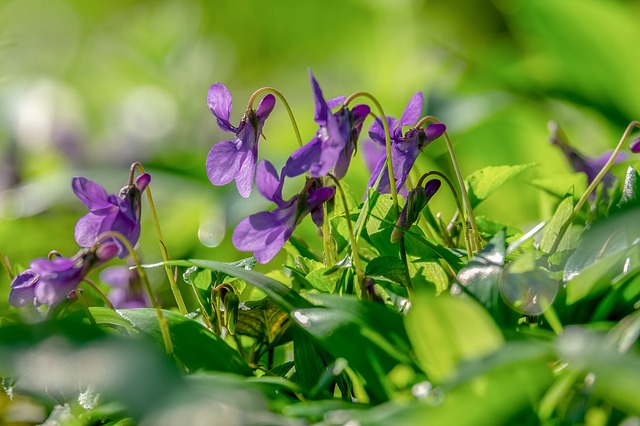
Toxic Flowers
While there are a lot of tasty edible flowers to be found in the garden, there are plenty of toxic flowers too. This is by no way an inclusive list, but here are a few toxic flowers to avoid:
- Azalea
- Daffodil
- Dogbane
- Henbane
- Hyacinth
- Hydrangea
- Oleander
- Wisteria
Here’s a much more exhaustive list of toxic flowers, but it’s obviously not all that exist, just most of the common ones.
What’s your favorite edible flower? Did I miss any? Leave me a note in the comments.
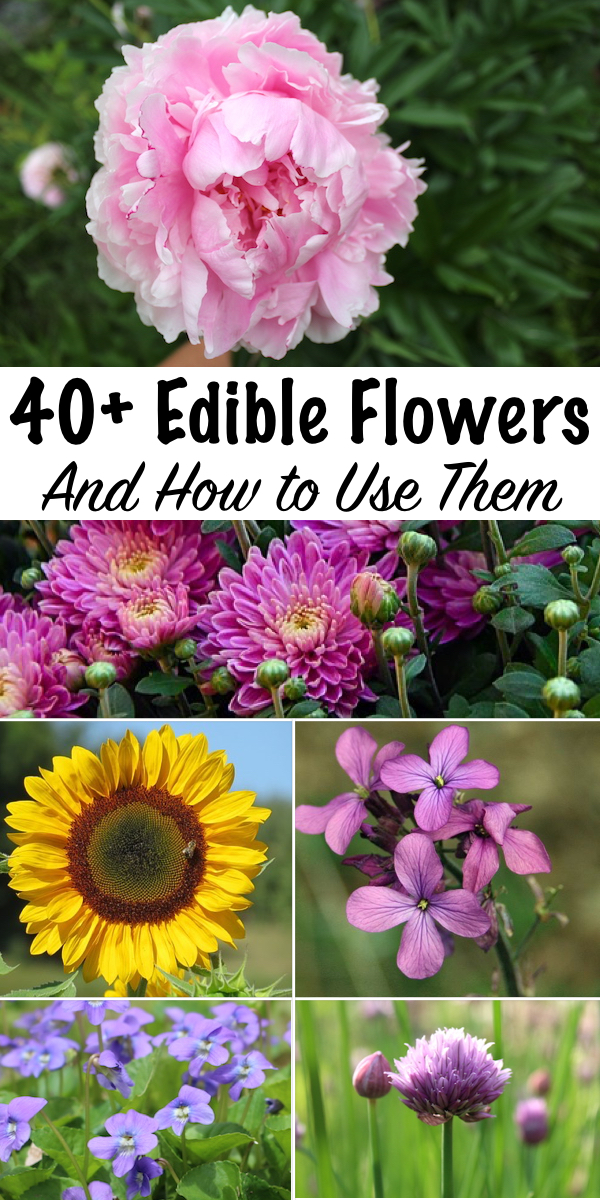
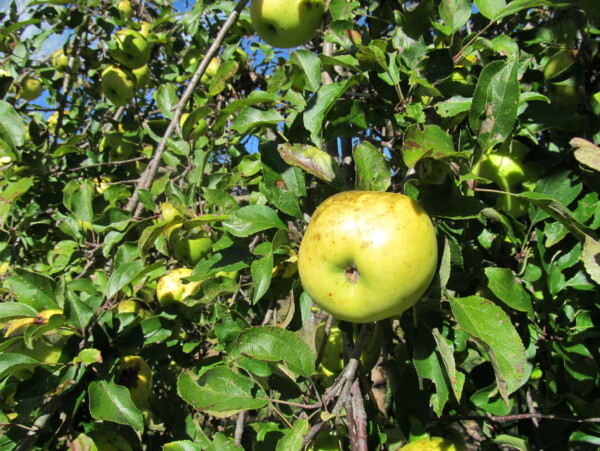



Wisteria flowers are not toxic, but the rest of the plant is. All of the green parts. Everything but the blooms. I make wine from mine every year, but am very careful to only use the blooms. The wine is sweet/tart like some peaches or nectarines. It’s absolutely delicious It’s my favorite wine. Everyone I’ve shared it with loves it. No one has ever gotten sick from it.
I was wondering about yellow bush daisies? Can you eat them?
Do you have a scientific name for this plant?
Wisteria is much like honeysuckle in that the blossoms are not toxic although the rest of the plant is.
It is my understanding that the entire plant is toxic but that most of the toxins are concentrated in the seeds and seed pods.
I love your emails. Thank you so much for information. I can’t wait to start this spring on some of these . Keep up the good work, I greatly appreciate all of it.
You’re very welcome. We’re so glad that you enjoyed it.
While Hydrangeas are said to be poisenous, there is a variety that is used in tea ceremonys in Japan. it is the Hydrangea serrata ‘Oamacha’. Oamacha means sweet tea. You can either dry or traditionally ferment the leaves for tea. I have not tried tris yet but I will soon since they have one in our cities botanical garden 🙂
Thank you so much for the information! Very helpful.
You’re very welcome. So glad you found it helpful.
Thanks so much 😍
You’re very welcome.
Teriffic article, Ashley!! Thank you for taking the time!
You’re welcome. So glad you enjoyed it!
Great post! Saved! Thanks for sharing.
Thank you!
Excellent.Thanks everso.Melissa
What a great post, so packed with information. I love all of your work-thanks so much for doing it!
LOVED this article! So much information!
I would urge you to make changes in regard to your commentary on tulips. Though they were eaten in some situations during the Great War, there have been many cases of tulip toxicity from the bulbs. https://www.poison.org/articles/tulip-bulb-toxicity-191
I loved reading this post. Thank you for all the information and the quick pics. So many of these I knew about but a few I did not. I love how you write with so much info in such little space. It’s tough for me to keep reading when there’s too much “filler”. Anyway, I have been looking to add to our yard so that the grandchildren can play in a beautiful safe environment, this helped me choose some edibles, so I can teach them what’s ok to eat and make good memories. Thank you!!!
What an amazing post! LOVELOVELOVE!
We’ve been enjoying our violets and dendelions, and there’s so much more to explore! Thanks!
I loved this post,as I do many of yours. There is such good information and I learn something new all the time. I do have to relate that as a child, I went around eating plants that looked good to me. I loved wood sorrel, that I assumed was a kind of clover ,for its lemony taste. I also LOVED azalea blooms,also for that lemony taste. I never knew until I was a much mature adult,that they were poisonous! I have never done it since.
Thanks for sharing! Clearly, azalea’s aren’t that poisonous, especially if you didn’t even get a stomach ache. Maybe you have to eat a lot of them? Even spinach is poisonous if you eat too much, so maybe it’s a dosage thing. Kinda makes me want to try one…
Thank you! I LOVE this post! So packed with information and resources, I can’t imagine the huge amount of research that must have gone into it. Thank you, again. I am so happy to have found your blog!
Wonderful, glad you enjoyed it!